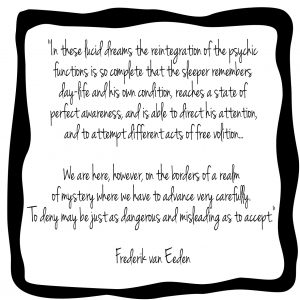
 Lucid dreams are a phenomenon that have been explored in depth for centuries. There is a rich and deep history of dream exploration dated back as far as 5000 years ago. Indeed, modern research still continues to examine and explore dreams in an attempt to fathom what they are, why we have them, and potentially how understanding them may unlock secrets to holistic wellbeing. Further, while modern science can offer new technologies into understanding the chemical interactions that are present in each stage of dreaming and their value, there are limitations and questions that potentially only ancient wisdom can unlock.
Lucid dreams are a phenomenon that have been explored in depth for centuries. There is a rich and deep history of dream exploration dated back as far as 5000 years ago. Indeed, modern research still continues to examine and explore dreams in an attempt to fathom what they are, why we have them, and potentially how understanding them may unlock secrets to holistic wellbeing. Further, while modern science can offer new technologies into understanding the chemical interactions that are present in each stage of dreaming and their value, there are limitations and questions that potentially only ancient wisdom can unlock.
This then evokes the question: Why?
Why would I want to cultivate my dreams? Why would I want to aim to experience lucidity, and indeed, why on earth would I want to work in waking hours AND work in sleeping hours? Isn’t sleep meant for recuperation?
There are many answers to these questions, and although each answer holds a personal aspect that only you can answer, the aim of this article is to answer some of these questions by looking at the definitions of “lucidity” and “dreaming”; by looking at exactly what lucid dreaming is, and furthermore, by answering more directly the question of why. We will then look into the how and offer some great techniques that, should you decide to explore your dreams in more depth, will allow you to begin to cultivate dream experiences, and potentially begin to unlock the secrets of your mind.
A broad, and more literal definition of Lucid Dreaming
Quite often when trying to understand concepts, looking at the literal definitions of the terms involved, allows us to “wrap our heads around” what the concepts might actually be trying to tell us.
Such is true with lucid dreaming.
Lucid by (Merriam-Webster adaptation) definition is
1 : Suffused with light
: Translucent
2 : Having full use of one’s faculties
3 : Clear to the understanding, intelligible
Dream by (Merriam-Webster adaptation) definition is
1 : A series of thoughts, images, or emotions occurring during sleep
2 : An experience of waking life having the characteristics of a vision (clarity of the future, imagination)
: State of mind marked by abstraction or release from reality
: Objects seen in non-ridged awareness
3 : Something notable for its beauty, excellence, or enjoyable quality
As you can see, by definition lucid dreaming is the state in which our thoughts, images and / or emotions are illuminated in clarity, while seemingly having the full use of our faculties. Or as more commonly described, it is the ability to be aware of the dreaming state while you are dreaming.
Ancient wisdom, particularly Tibetan tradition, acknowledges the value of dreams. As such, one way to see lucid dreaming is the pathway towards apprehending dreams and dissolving the dream state. This is done in order to practice the non-duality of consciousness that leads one towards greater awakening and freedom of suffering. Through uniting body, mind, and soul in non-dualistic presence, objective forms (thoughts, earth bound “things”, and emotions) are no longer solid, lasting, and independent. Rather objective forms are fluid, malleable, interdependent, and able to be cultivated.
To further this flexible approach scientific research has allowed us to see that this is possible through neuroimaging. Due to the reality that in a sleep state all external sensory data is removed, the Thalamus (the governor of need, and the chemical regulator that links to the nervous and endocrine system,) takes a “break” and allows our bodies to relax in full homeostatic (our set point) attendance. In this state we can become attuned to our internal sensory data as based in past and current states (refer to Van Der Kolk, The Body Keeps the Score for research on past internal sensory states held captive in the body in stress). This allows our conscious and subconscious states to align, become illuminated, and most importantly to integrate in rational non-attachment, thus opening the path toward enlightenment as it is understood in eastern traditions.
Say what now? You lost me at the ability to be aware of the dreaming state while you are dreaming!
Basically, in both the east and the west the aim of lucid dreaming is to awaken consciousness in the dream state allowing flexibility in response and the ability to explore the depths of our minds.
In saying that, there may be one essential element in lucid dreaming that differs in the east and west: intention.
It is important before attending to our dreams and delving into our subconscious mind, that we are intentional about our intention. In Tibetan tradition the intention of lucid dreaming is to broaden the spectrum of experience in order to awaken the mind on the path to enlightenment, as well as to open the heart towards compassion and kindness. In the western culture however, quite often the intention of lucid dreaming is not to awaken, rather it is to escape, to enhance worldly matter, or for pure self-fulfillment.
 With this in mind we can begin to understand that lucidity exists on a spectrum. In low-level lucidity we may distinguish the state of being aware and present in a dream, however recognition of dream representations and the inability to experience harm, or the acknowledgement of the paradox of wakefulness in sleep goes unattended. Conversely, in high-level lucidity we experience the non-duality of reality where there is a recognition of the dream state and the ability to amalgamate subconscious representations with conscious awareness, to manipulate “data” as there is no real danger, and so too to know that we are asleep and will awaken.
With this in mind we can begin to understand that lucidity exists on a spectrum. In low-level lucidity we may distinguish the state of being aware and present in a dream, however recognition of dream representations and the inability to experience harm, or the acknowledgement of the paradox of wakefulness in sleep goes unattended. Conversely, in high-level lucidity we experience the non-duality of reality where there is a recognition of the dream state and the ability to amalgamate subconscious representations with conscious awareness, to manipulate “data” as there is no real danger, and so too to know that we are asleep and will awaken.
This then leads us to the why: Why would I want to cultivate my dreams in lucidity?
Firstly, the main purpose – as aforementioned, is to awaken to a place where reality and perception meet in non-judgmental awareness. It is the place where we are able to allow ourselves to let go of reality in order to cultivate the true meaning of reality – which is ultimately the paradox of existence: when we are awake we are asleep to the truth, and when we are asleep we are awake to the truth.
There are elements to these concepts that bring us closer to seeing that rather than being solid, lasting, and independent, our lives, humanity, is actually very fluid, malleable, and interdependent. When we are able to come to a place that accepts this flexibility of mind, what is absolute becomes perceptually and neurologically plastic thus opening the “planes of possibility” (see Dr Dan Siegel’s work) where our energy can be cultivated and expanded. This then opens more internal space for kindness and compassion where the “awakened ones” come to raise the “sleepers” by understanding that life is perception of self and other.
Further, lucid dreaming can be seen as the beginning of rapid transformation on the journey towards enlightenment. As our subconscious minds have a vast influence over our conscious minds, it makes sense to let go of entrapment and disintegration. In lucidity we can cultivate adventure and bravery, creativity and problem solving, and perhaps most pertinent to todays closed culture – healing.
With suppleness of mind, there is the potential to transform our past and to foster a space for liberating courage. Again, this is where east meets west, where tradition and science come together to allow healing of nightmares (real or imagined) and trauma. There is a lot of research that surrounds the notion of fears, anxiety, and indeed, of trauma that is stored implicitly within the body. What we see in lucidity is that, with the knowledge that we are safe and nothing is solid or lasting, we can effectively turn around in our dreams and face our deepest fears: the fears are real, the danger is not. Moreover, in the case of trauma, reestablish sensory equilibrium in order to allow trapped memories and emotions to merge in acceptance and integration.
As Tenzin Wangyal recognized (as acknowledge by Andrew Holock, 2017):
“Just as dream objects can be transformed in dreams, so emotional states and conceptual limitations can be transformed in waking life. With experience of the dreamy and malleable nature of experience, we can transform depression into happiness, fear into courage, anger into love, hopelessness into faith, and distraction into presence… To challenge the boundaries that constrict you.”
What could be more magical and miraculous than that?
With all this in mind, now we come to: How?
As with any skill or trait, lucid dreaming can be cultivated through setting a clear intention as well as through repeated actions that become habitual and then characteristic. Below, we will discuss setting intention, dream recall, reality testing, and sleep interruption – a selection of techniques recommended by Stephen LaBerge, 1986. However, as there is so much more information that can assist you in lucid dreaming, we recommend coming to one of Celia Roberts Retreats where you will be able to learn and practice techniques in a group of like minded people. Be sure to view our 2018 packages – specifically our Healthy & Restorative Sleep Retreat April 28 & 29 next year!
Intention
The most essential aspect of lucid dreaming is your intention, which, in itself, is two fold. Firstly, by intention, we mean the long-term intention that goes deeper then “I want to awaken in my dreams”. This type of intention is thinking in a more profound way towards your objective. Ask yourself, what is it that I am looking to achieve? What is my volition and why? Am I willing to experience the spectrum of experience? Why? Is this for self- fulfillment, or for awakening to the non-duality of reality? It is our intentions that create our characteristics, our heart, and our spirits karma – what is your intention and why?
The second element of intention is short-term. Meaning, the intention we set daily. These may be cultivated through:
- Setting time aside to achieve the specific tasks designed to assist with lucid dreaming.
- Repeating mantra’s that state your intention to initially remember dreams, then towards the intention to awaken in your dream.
- Creating a mindset that removes any judgment or preconceived notions around dream interpretation.
All of these can be cultivated though weekly or daily yoga and meditation practices, by joining like minded people in conversations, or perhaps by simply taking the time to become more attuned to your inner-most being.
Dream Recall
Cultivating awareness first involves becoming adept in dream recall. There are many techniques, many of them available from either Stephen LaBerge or Andrew Holecek, however the consensus is to:
- Keep a dream journal beside your bed. On waking take a few moments to deeply breath into the darkness behind your eyes and jot down any thoughts, emotion, or images that come to mind. Try saying “was I dreaming” and to remove judgment or analysis. The task is exploration, noticing. Try, “oh, I notice rainbow” “I see person, person feels familiar, friendly”.
- Document dream signs – repeated objects (emotions, thoughts, images, people) within the dreams.
- If recall is fuzzy or you feel yourself grasping, come back to the breath, focus on sensation, and allow yourself to be.
- Dream recall requires time: open, present time – be sure to allow yourself the space for this process, as without it lucid dreaming will forever be out of your grasp.
Reality Testing
There are many ways to reality test. Andrew Holecek suggests:
“during the day [if] something weird happens, sensitize yourself. Anything bizarre. It happens all the time. At that point, conduct a state check. What you will find, and I promise you this is the case—just pure physics, cause and effect—that habit will start to transpose into the night, and whenever something happens in your dream state, which of course happens all the time, you may in fact now start to find yourself jumping up in your dream to conduct the state check. Why? Because you’ve been doing it during the day.
Now, lo and behold, you do it in the dream and instead of coming back down, you’ll either come back down and go through the dream ground, or you’ll just keep going and there will be a recognition that says, ‘Wait a second here. I can’t do this if I’m awake. I must be dreaming.’ And bang, you’re in”. (Andrew Holecek, 2016)
Potentially a more effective, and less obtrusive, technique is that by Stephen LaBerge. Stephen recommends checking something text based. For example check your digital watch at specific repeated locations during the day. i.e. when you arrive at the office or when you are in line at the coffee shop. However, when doing this one must, check, look away, and then check again.
“Research shows that text in dreams changes 75% of the time it is re-read once and changes 95% it is re-read twice. If the characters do change, or are not normal, or do not make sense, then you are most probably dreaming. If the characters are normal, stable, and sensible, then you probably aren't dreaming” (Stephen LaBerge, 2015).
Sleep Interruption
Again, referring to the two experts in the field, another technique towards cultivating lucid dreams is sleep interruption. This is the process of intentionally waking yourself up, taking 30-60 minutes to meditate, practice reality checks, read, and go back to sleep. As you fall back to sleep use the MILD Technique.
With all this in mind remember that initially, it is about taking the time to set intention and to recognize that to remove duality, we first have to admit to it, distinguish the dual states, and further establish patterns in our waking hours towards removing them. As aforementioned, this looks like cultivating characteristics during waking hours that can be replicated during sleep – no matter what phase.
If you are specifically interested in working with a mentor, or within a group setting, please take the time to visit our class and retreat pages as both yoga and meditation open many avenues towards creating intentions, mindfulness, relaxation, and a holistic sense of wellbeing that begins to alter your perception.
Alternatively, consider booking a private consultation in order to better inform your practice and to get one-on-one guidance in your intentions.
Further Insights:
Information Sourced from:



